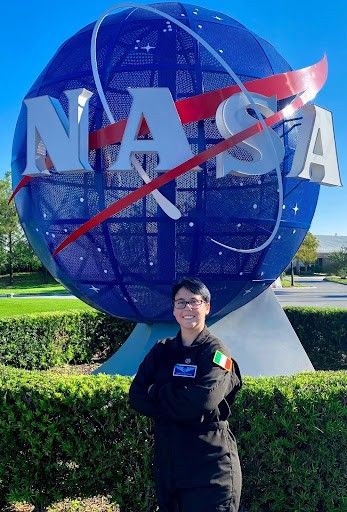Titans Space Industries, a commercial space company, selected a new cohort of astronaut candidates this spring – and among them is NASA citizen scientist, Benedetta Facini. She has participated in not one, but many NASA citizen science projects: Cloudspotting on Mars, Active Asteroids, Daily Minor Planet, GLOBE, Exoasteroids and International Astronomical Collaboration (IASC). We asked her a few questions about her work with NASA and her path to becoming an astronaut candidate.
Q: How did you learn about NASA Citizen Science?
A: Through colleagues and social media, I often came across people talking about Citizen Science, and this immediately caught my curiosity. I did some online research on the subject, and I asked some colleagues already involved in it. Finally, I managed to find the way to participate by exploring the programs offered by NASA Citizen Science, which impressed me with their variety.
Q: What would you say you have gained from working on these NASA projects?
A: Curiosity in discovering new things and a lot of patience: many projects indeed require attention and, as mentioned, patience. I was pleased to discover that even NASA relies on “ordinary people” to carry out research, giving them the opportunity to learn new things using simple tools.
I also gained hands-on experience in analyzing real data and identifying celestial objects to contribute to real research efforts. My favorite part was to learn to recognize the pattern of clouds in data collected by the Mars Climate Sounder on the Mars Reconnaissance Orbiter.
I have learned the importance of international collaboration: I know many citizen scientists now, and interacting with them teaches me a lot every day.
Q. What do you do when you’re not working on citizen science?
A: I am a student and a science communicator. I share my knowledge and enthusiasm through social media, schools, webinars around the world, and space festivals across Italy where I have the opportunity to engage with a wide audience, from young students to adults.
Recently, I achieved a major milestone: I was selected as an Astronaut Candidate by the commercial space company, Titans Space Industries. I am thrilled to soon begin the basic training, which marks the first step toward realizing my dream of becoming an astronaut and contributing directly to human spaceflight and scientific research.
Q. What do you need to do to become an astronaut?
A: Gain as much experience as possible. During astronaut selection, not only academic achievements are evaluated, but also professional and personal experiences.
Every skill can be useful during the selection process: the ability to work in a team, which is essential during space missions; survival skills; experience as a diver, skydiver, or pilot; knowledge of other languages; and the ability to adapt to different situations.
I would also like to debunk a myth: you don’t need to be Einstein and fit as an Olympic level athlete; you just need to be good at what you do and be healthy.
Q: How has citizen science helped you with your career?
A: Citizen Science was very helpful for my career as a science communicator, as it gave me the opportunity to show people that anyone can contribute to the space sector. At the same time, it has allowed me to become a mentor and a point of reference for many students (mainly with the IASC project).
The hands-on experience I gained in analyzing real data was also very helpful for my academic career, too. I had never had real data to work with before, and this experience proved extremely valuable for the practical courses in my physics degree program.
Q. Do you have any advice you’d like to share for other citizen scientists or for people who want to become astronauts?
A: For other citizen scientists my advice is to stay curious and persistent.
Don’t be afraid to ask for help and interact with other colleagues because the goal of the NASA Citizen Science program is international collaboration and every small contribution can make a difference.
For aspiring astronauts, my advice is to gain as much experience as possible. Academic results are important but hands-on skills, teamwork, adaptability, and real experiences are also important.
Stay passionate and never lose your curiosity; the astronaut path is challenging; don’t give up after an eventual first rejection. You will always meet people trying to make you change your mind and your dream, even people from your family, but don’t stop in front of obstacles. The greatest regret is knowing you didn’t try to make your dream come true.
Quoting my inspiration, Italian astronaut Paolo Nespoli: “You need to have the ability and the courage to dream of impossible things. Everyone can dream of things that are possible. Dream of something impossible, one of those things that, when you say it out loud, people look at you and say: “Sure, study hard and you’ll make it,” but deep down no one really believes it. Those are the impossible things that are worth trying to do!”
Q: Thank you for sharing your story with us! Is there anything else you would like to add?
A: I would like to thank the team behind NASA Citizen Science.
These projects play a crucial role in keeping students’ passion for science alive and guiding them toward a potential career in this field.
Knowing that I have contributed to helping scientists is incredibly motivating and encourages me and students around the world to keep going, stay curious, and continue pursuing our path in the science field.
The opportunity to participate in these projects while learning is inspiring and it reinforces the idea that everyone, regardless of their background, can make a real impact in the scientific community.
